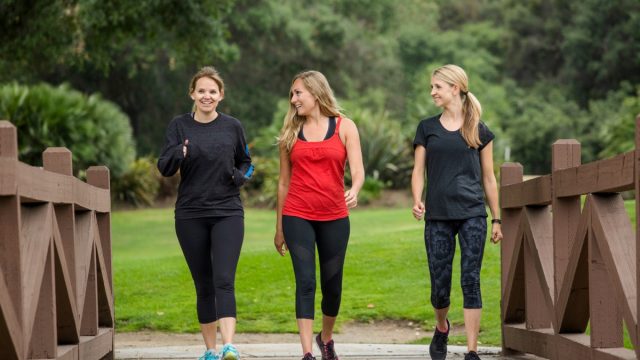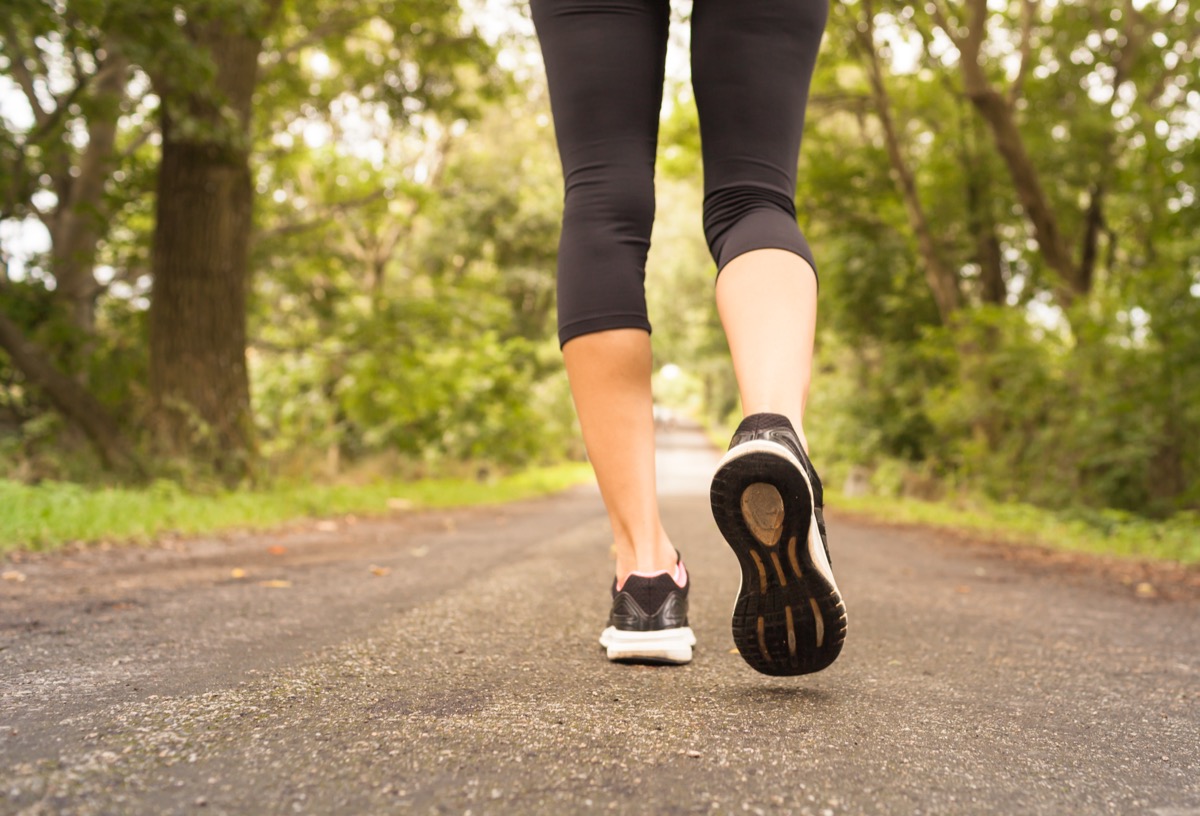7 Walking Mistakes You're Making—And How to Fix Them
Reap big benefits without adding strain or injury.

Walking comes with many of the benefits of more intense aerobic activities, without the added risk of major strain or injury. In fact, recent research about the benefits of walking seems almost too good to be true. Several studies have determined that taking a daily stroll can help lower your risk of heart disease, Type 2 diabetes, cancer, and other chronic illnesses. Though more is better, just 4,000 steps per day can reduce your risk of dying from any cause, says a 2023 study published in the European Journal of Preventative Cardiology.
However, that doesn't mean you shouldn't take certain precautions if you plan to make walking part of your health and wellness routine. Experts say there are a few common mistakes people make when walking for fitness that can cause chronic pain or acute injury. Ready to get it right? These are the seven walking mistakes you're making and how to fix them.
RELATED: Walking Pads Are the Latest Wellness Trend Everyone's Talking About.
1
Using your arms the wrong way

You probably don't give much thought to your arms when you walk, but experts say that moving your arms the wrong way can greatly impact your balance, posture, and more.
"Your arms are essential to propelling you forward while walking. If your timing is off or you don't use your arms at all, this can slow you down and make you less efficient," explains Marshall Weber, CPT, a personal trainer and gym owner at Jack City Fitness.
To get it right, swing your arms gently and naturally, extending one arm in coordination with the opposite side leg, then switching with each step.
2
Having poor posture or looking down

If you're walking on uneven terrain, some research suggests that it may help your balance and postural control to look where you're walking.
However, making a broader habit of looking down at the ground or your phone can create tension in the cervical and thoracic spine, ultimately leading to back and neck pain and setting a precedent of poor walking posture.
"It is vital to have good posture while you are walking to help you breathe easier and more efficiently," Weber tells Best Life. "You should try to look ahead of you about 15 feet in front while you walk and keep your chin up."
Joyce Shulman, founder of Jetti Fitness and the author of Why Walk?, agrees that many people fail to set and maintain good posture when they walk—especially when they're trying to increase their speed and intensity.
"When we walk, our hips should be aligned over our feet, our shoulders should be aligned over our hips, and our ears should be aligned over our shoulders. We need to avoid slouching forward, constantly staring down at our feet, or, conversely, arching our backs," she notes.
RELATED: Why Walking Only 3,867 Steps a Day Is All You Need, Science Says.
3
Walking too much too soon

Walking is most beneficial when it's part of your regular routine. That's why it's so crucially important not to overdo it early on and burn yourself out for next time.
"When starting a new exercise routine, gradually increasing the distance and intensity is important," says James Rodgers, an elite runner who shares training tips. For example, if you've only ever walked in two-mile increments in the past, don't try to walk 10 miles right away.
"It's best to build up gradually with progression, as it will be better for your physical health and more enjoyable overall. As always, if you are starting a new routine, it can be worth checking in with a doctor or medical professional," Rodgers adds.
4
Carrying a non-fitted backpack or handbag

Rucking—carrying extra weight in a backpack while walking long distances—can be a great way to increase the intensity and benefits of your walk. However, if your backpack fits poorly, this can cause major strain in many of your major muscle groups.
"If you plan on carrying a backpack with drinks, snacks, or extra kit, it's important to ensure that the straps are fitted correctly and that the backpack is positioned suitably on your back," says Rodgers. "As you do not want to lean too far forward or backward when walking, it's worth going to a store to help fit the backpack properly."
Similarly, it's important to never sling a backpack over one shoulder or carry a tote bag or heavy handbag while walking longer distances. The weight imbalance can cause asymmetrical pain and strain on one side of your back and shoulder, which can lead to long-term damage or discomfort.
RELATED: 5 Clothing Items You Shouldn't Wear on a Walk.
5
Overstriding

There are many possible ways to increase the intensity of your walks for greater benefit—for instance, carrying weights, walking uphill, picking up the pace, or adding intervals. However, Shulman says that in an effort to do so, many people make the mistake of "overstriding."
"Stride is the distance you cover when you take two steps (one with each foot)," Shulman explains. When we overstride, we fail to land with our foot beneath our center, taking too long of a step and over-extending the leg.
"Overstriding can put more strain on our back and inhibit our ability to maintain that all-important posture and alignment. This can lead to a variety of potential stresses, strains, and overuse injuries," the author notes.
Rodgers agrees that this is a common concern, and adds that it can ultimately cause joint damage. He says that if your aim is to increase the intensity of your walk, focus on increasing your cadence—or the number of steps taken per minute—instead.
6
Thinking short walks aren't worth it

There are certainly benefits to taking longer walks, but Shulman says if you only have 10 minutes to get moving, that can still do a great deal of good.
"When people set out to create a walking routine for the sake of fitness, they often tell themselves that if they don't have at least 20 or 30 minutes to walk, then 'why bother?' But breaking up your walks into smaller increments can be just as effective as one long walk for the sake of many health markers," Shulman tells Best Life. "If you only have 10 minutes, take the walk."
RELATED: 6 Best Walking Workouts for Weight Loss.
7
Wearing poor-quality shoes

There are some things you should always buy in person instead of on the internet. Shoes that you intend to wear on long walks are a perfect example.
Rodgers says you should always try on footwear and compare comfort between brands before buying a new pair of shoes. Look for good arch support, adequate cushioning, and shock absorption.
"To avoid [injuries], find a walking shoe that suits the terrain you'll be walking on and provides protection and comfort. Investing in suitable footwear and gear is much better than spending money on physiotherapy due to an injury caused by improper footwear," he shares.
Best Life offers the most up-to-date information from top experts, new research, and health agencies, but our content is not meant to be a substitute for professional guidance. If you have health questions or concerns, always consult your healthcare provider directly.





















